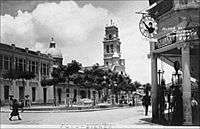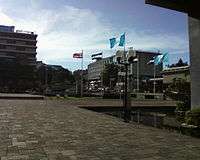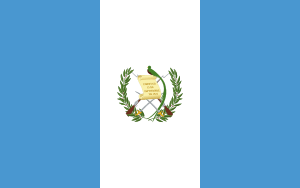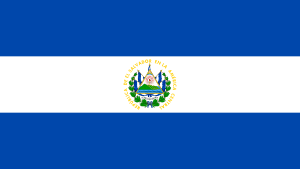Sólo de noche vienes
Sólo de noche Vienes is a Mexican film produced by Panamerican Films and Guatemalan producer Manuel Zeceña Diéguez and directed by Sergio Véjar.[2] It starred Elsa Aguirre and Julio Alemán along Cosmo Alessio, Rodolfo Landa, Herbert Meneses and Regina Torné. The plot is about a forbidden romance that takes place during Holy Week in a city in Central America.[2] In the 21st century Sólo de noche vienes is also an important film documentary of the Holy Week processions in Guatemala of the 1960s.[3]
| Sólo de noche vienes | |
|---|---|
| You only come at night | |
| Directed by | Sergio Véjar |
| Produced by | Manuel Zeceña |
| Screenplay by | Elena Garro[lower-alpha 1] |
| Based on | Original work by Elena Garro written specifically for the movie. |
| Starring |
|
| Music by | Charles Trenet, Los Hermanos Cárcamo |
Production company | Panamerican Films |
Release date | 1965 |
Running time | 95 minutes |
| Country | México |
| Language | Spanish |
Plot



Andrés Villalta is a Mexican tourist visiting a city in Central America to enjoy the Holy Week processions and meets Remedios -a local socialite who is married to one of the most powerful men in the country-, with whom has an instant spark. Then, Carmen -Remedios sister-in-law- suddenly appears and Remedios hides from her without giving any explanations to Andrés. Afterwards, when Andrés takes her home in his fancy sports car, Remedios lies to him telling that her name is Carmen -his sister-in-law's name- and omitting to say that she is married.[3] confusion ensues, which makes Remedios even more mysterious to Andrés.[4]
During the climax, the whole family has gathered to watch Virgen Mary's silent procession, and then Andrés sees Remedios and when tries to reach for her, Remedios husband's cronies kill him on the spot. Andrés dies in Remedios arms, still calling her "Carmen".[4]
The movie was directed by Sergio Véjar, and is based on a screenplay written specifically for the movie by the Mexican writer Elena Garro; Garro producer Manuel Zeceña and Véjar all worked on the final version of the screenplay. The plot shows the impossible love between a Mexican tourist and a mysterious lady that appears and vanishes as if she were a spirit or coming from a different dimension; Guatemala during Holy Week is the perfect frame for the mysterious romance. The elusive woman was actually married to a powerful character, who upon discovering her liaison orders the killing of her lover right there during a procession. The climatic scene shows both the infinity of the horizon, the rigidity of the religious and the volatility of love. Since the plot was originally written for the movie it was not included in the literary works of Garro.[5]
Filming
The film was filmed in Guatemala and El Salvador and at the time the most intriguing part of it all was the fact that producer Manuel Zeceña was able to get Alemán and Aguirre to work together after they had been strained for a while.[6] Interiors were filmed mainly in San Salvador, in private homes in Santa Tecla and the exclusive neighborhoods of Escalón and San Benito.[3] The exteriors, on the other hand, were filmed in tourist attractions in "Puerta del Diablo" and "Planes de Renderos", also in El Salvador; however, since the plot is around a tourist that went to Central America to watch the Holy Week processions, several processions were filmed in Guatemala City. Therefore, the movie takes place in a fictitious city which is represented alternatively by San Salvador and Guatemala City.[7]
Soundtrack
Soundtrack was composed by French composer Charles Trenet.[5] The Salvadorian singers "Los Hermanos Cárcamo" (The Cárcamo Brothers) sang the title song Te deseo, amor (I lust for you, love). Roberto Cárcamo, lead singer, told to an interviewer on February 2002, that they had the opportunity to perform for the move after Julio Alemán heard them at Hotel El Salvador Intercontinental where he was staying during filming.[7]
Reception
In Costa Rica, the movie opened on May 1967 and due to the strong controversy the plot had for the times, it was shown in a censored version and only for mature audiences that were at least 21 years old.[6]
Top billed cast
- Elsa Aguirre: Remedios
- Julio Alemán: Andrés Villalta
- Regina Torné: Carmen
- Rodolfo Landa: Marcial (Remedios' husband)
See also



- Guatemala City
- San Salvador
- Holy Week processions in Guatemala
Notes and references
Notes
- Elena Garro was a well known Mexican writer who was married to Literature Nobel Prize winner Octavio Paz.[1]
References
Bibliography
- Barillas, Edgar (2013). "50 películas filmadas en Guatemala y una que no (1935-1996). Apuntes para una cartografía de los lugares filmados en Guatemala". Revista Historia de la Universidad de San Carlos de Guatemala (in Spanish). Guatemala. Archived from the original on October 22, 2015. Retrieved 22 October 2015.CS1 maint: ref=harv (link) CS1 maint: unfit url (link)
- CONACULTA (2013). "Elena Garro, una mujer de letras" (PDF). CONACULTA, Dirección general de comunicación social (in Spanish): 1. Retrieved 24 June 2015.CS1 maint: ref=harv (link)
- Letra Celuloide (31 March 2013). "Adaptaciones de obras de Elena Garro". LETRACELULOIDE - Revista virtual de cine y literatura (in Spanish). Buenos Aires, Argentina. ISSN 1851-4855. Archived from the original on 28 March 2014. Retrieved 24 June 2015.CS1 maint: ref=harv (link)
- La Nación (24 May 1967). "Junto en "Sólo de noche vienes" -Elsa Aguirre y Julio Alemán". La Nación (in Spanish). Costa Rica. Retrieved 24 June 2015.CS1 maint: ref=harv (link)
- Panamerican Films (1965). "Sólo de noche vienes". YouTube (in Spanish). Guatemala y El Salvador. Retrieved 23 June 2015.CS1 maint: ref=harv (link)
- Perdomo León, Oscar (11 March 2014). "San Salvador en "Sólo de noche vienes"". La casa de Oscar Perdomo León (in Spanish). Archived from the original on 17 February 2015. Retrieved 24 June 2015.CS1 maint: ref=harv (link)
- Santos, Israel (18 June 2015). "De cuando Cristo Rey, La Merced y El Calvario llegaron a la pantalla grande". Cucurhco en Guatemala (in Spanish). Guatemala. Archived from the original on 19 June 2015. Retrieved 24 June 2015.CS1 maint: ref=harv (link)